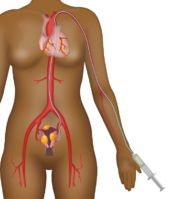If you suffer from heavy periods or pain with sex, these could be warning signs of uterine fibroids, adenomyosis or endometriosis. In fact, these three uterine conditions have a lot of overlapping symptoms. And both endometriosis and adenomyosis can be difficult to diagnose, leaving many women diagnosed with an endometriosis or uterine fibroid diagnosis when they actually have adenomyosis.
Luckily, our interventional radiologists in Dallas can treat both fibroids and adenomyosis. But to properly target your treatment, you need an accurate diagnosis. So, for information on all three conditions, keep reading below!

Fibroids, endometriosis and adenomyosis all share common symptoms. However, they are each distinct concerns. And all will need to be treated appropriately.
To begin with, uterine fibroids are typically non-cancerous uterine tumors that form on the interior, exterior or attached to the organ via stalk-like growths. Depending on the size and number of tumors in your uterus, you may experience one or more disruptive symptoms, many of which are shared by women with adenomyosis and endometriosis.
Yet adenomyosis is a condition in which your endometrial tissue grows into the muscles of your uterus, often leading to pelvic pain and heavy periods, among other concerns. Similarly, endometriosis is a condition in which your uterine tissue grows in the wrong place. Yet, with this condition, the tissue migrates out of the uterus, forming on other internal organs, and causing many disruptions to your daily life.
Now, all three conditions share symptoms such as pelvic pain, painful sex and heavy periods. Sometimes, that makes it harder to diagnose the cause of your discomfort. Yet, with the right diagnostic tools, you can discover whether you have fibroids, adenomyosis or endometriosis. Then, we can provide relief for your pain, without removing your uterus or even performing invasive surgery.
While the Dallas Fibroid Center doesn't treat endometriosis, we do provide non-surgical relief for both adenomyosis and fibroids via artery embolization. During this procedure, our interventional radiologist will block blood flow to your uterine artery, allowing your tumors to shrink if you have fibroids, and relieving adenomyosis symptoms if your uterine tissue has grown into the organ's muscular wall. Want to learn more about UAE? Click here to request an appointment with our Dallas-based experts and learn why UAE is an effective adenomyosis treatment.

Our Locations
Monday - Friday
8am - 5pm
Dallas
3920 W Wheatland Rd,
Suite 108,
Dallas, TX 75237
Plano
5425 W. Spring Creek Parkway,
Suite 100
Plano, TX 75024
Scheduling
Please contact our dedicated specialists to schedule a consultation today.
2025 Dallas Fibroid Center. All rights reserved. Website Design by Healthcare Success